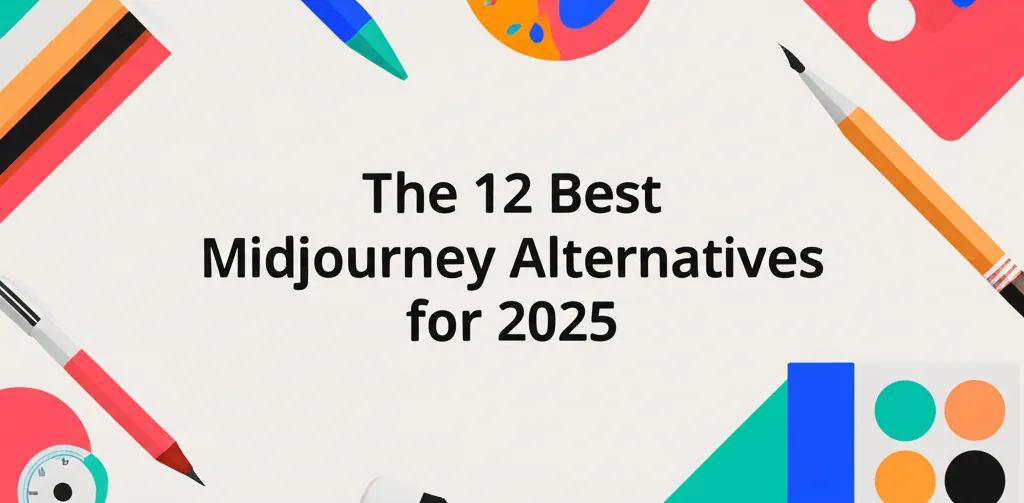Developer Offer
Try ImaginePro API with 50 Free Credits
Build and ship AI-powered visuals with Midjourney, Flux, and more — free credits refresh every month.
Midjourney Alternatives: A Pro Guide for Developers & Designers
Midjourney Alternatives: A Pro Guide for Developers & Designers
This guide cuts through the noise to help you, the professional developer or designer, find the perfect AI image generation tool beyond Midjourney's walled garden.
Midjourney has set a high bar for AI image quality, but its closed ecosystem and Discord-only interface present real limitations for professional workflows. For developers who need API access and designers who require deep integration and commercial clarity, the search for a powerful Midjourney competitor is on. This guide breaks down the best Midjourney alternatives, focusing on the features that matter most to technical and creative professionals: API access, open-source flexibility, licensing, and overall control.
Midjourney Alternatives: A Feature Comparison for Professionals
| Tool | API Access | Generous Free Tier | Open Source | Commercial Use | Best For |
|---|---|---|---|---|---|
| Stable Diffusion | Yes | N/A (Local Install) | Yes | Varies by Model | Developers & Tinkerers |
| Leonardo.Ai | Yes | Yes | No | Yes (Paid Tiers) | Designers & Game Artists |
| Adobe Firefly | Yes | Yes | No | Yes | Corporate & Agency Designers |
| BlueWillow | No | Yes | No | Yes (Paid Tiers) | Casual Users & Idea Generation |
| imaginepro.ai | Yes | Yes | No | Yes | Developers & Stock Photo Users |
The Best Midjourney Alternatives for Professional Workflows
Choosing a Midjourney alternative isn't about finding a 1:1 replacement; it's about identifying a tool that fits your specific professional needs. Whether you prioritize total control, seamless workflow integration, or programmatic access, there's a solution for you.
For Maximum Control: Stable Diffusion (The Open-Source Midjourney Alternative)
For developers and technical artists who want to look under the hood, there is no substitute for Stable Diffusion. As the leading open source midjourney alternative, its primary advantage is unparalleled control.
Instead of being locked into a specific service, you can run Stable Diffusion models locally on your own hardware using interfaces like AUTOMATIC1111. This means:
- No Filters or Restrictions: Generate anything you can imagine without corporate censorship.
- Custom Models: Train the AI on your own datasets to create unique styles or consistent characters.
- Endless Extensibility: A massive community provides extensions for everything from video creation to advanced upscaling.
The trade-off is a steeper learning curve. You are responsible for installation, updates, and resource management. But for those who need ultimate power, the effort is well worth it.
For Integrated Design: Leonardo.Ai & Adobe Firefly
For designers, workflow is everything. These tools excel at fitting into a professional creative process, making them some of the best paid ai image generators for professional designers.
-
Leonardo.Ai has quickly become a favorite for its cohesive, all-in-one platform designed for creators. It offers a suite of tools that Midjourney lacks, including AI Canvas for outpainting, model training on your own art, and features for generating consistent characters—a common pain point in AI art. Its user-friendly interface and robust feature set make it a top Midjourney competitor for creative production.
-
Adobe Firefly is Adobe's answer to generative AI, and its biggest selling point is trust. It is trained exclusively on Adobe Stock's licensed library and public domain content, making its output commercially safe for enterprise and agency use. Its true power is realized through deep integration with Photoshop and other Creative Cloud apps, allowing you to use features like Generative Fill directly within your existing projects.
For Programmatic Access: The Best AI Image Generator API
For developers, the ability to integrate image generation into applications, websites, or automated workflows is the most critical feature. An AI image generator API transforms these tools from creative toys into scalable services.
While you can host your own Stable Diffusion API, it requires significant infrastructure management. A more efficient approach is to use a dedicated API provider. Services like imaginepro.ai offer a streamlined solution, providing access to their proprietary models like Flux, or even a Midjourney API, through a simple REST API. This abstracts away the complexity of managing GPU servers and model updates.
Here is a basic example of how you might call such an API using Python:
import requests
import os
# Your API key and endpoint
API_KEY = os.getenv("IMAGINEPRO_API_KEY")
API_URL = "https://api.imaginepro.ai/v1/images/generations"
headers = {
"Authorization": f"Bearer {API_KEY}",
"Content-Type": "application/json"
}
data = {
"model": "flux-v1",
"prompt": "A photorealistic portrait of an astronaut, cinematic lighting, 8k",
"n": 1,
"size": "1024x1024"
}
response = requests.post(API_URL, headers=headers, json=data)
if response.status_code == 200:
image_url = response.json()['data'][0]['url']
print(f"Image generated successfully: {image_url}")
else:
print(f"Error: {response.status_code} - {response.text}")
This programmatic access is essential for building applications like dynamic avatar generators, automated content creation systems, or unique e-commerce product visualizations.
Frequently Asked Questions about Midjourney Alternatives
What is the best free alternative to Midjourney?
For a truly free experience, BlueWillow and Ideogram are excellent starting points. They operate on a freemium model similar to Midjourney's early days, offering a generous number of free credits to get you started. While they may lack the advanced control of Stable Diffusion or Leonardo.Ai, they are perfect for rapid brainstorming and casual use without an initial investment.
What's the main difference between Midjourney and Stable Diffusion?
The core difference is philosophy: Midjourney is a closed-source product, while Stable Diffusion is an open-source model. Midjourney provides a highly curated, easy-to-use experience that produces great results with simple prompts. Stable Diffusion provides a foundational model that gives you the power and responsibility to build your own experience, offering limitless customization at the cost of complexity.
Can I use images from Midjourney alternatives for commercial use?
This is a critical question, and the answer is: it depends on the service's terms. Adobe Firefly is explicitly designed for commercial use. Images from Leonardo.Ai's paid tiers are yours to use commercially. With Stable Diffusion, commercial rights depend on the specific model license you use—many are open for commercial use, but you must verify. Always read the terms of service before using any AI-generated asset in a commercial project.
Conclusion: Choosing the Right Tool for the Job
The search for the best midjourney alternatives ends with understanding your own needs. There is no single winner, only the right tool for a specific task.
- For Developers: If you need an open source midjourney alternative for maximum control or a robust AI image generator API for application integration, Stable Diffusion and API providers like
imaginepro.aiare your best bet. - For Designers: If you need a polished, integrated toolset for professional creative work, Leonardo.Ai offers an unmatched all-in-one suite, while Adobe Firefly provides unparalleled safety and integration for corporate workflows.
By moving beyond Midjourney, you gain access to a world of specialized tools built to empower professional creators and builders.
Compare Plans & Pricing
Find the plan that matches your workload and unlock full access to ImaginePro.
| Plan | Price | Highlights |
|---|---|---|
| Standard | $8 / month |
|
| Premium | $20 / month |
|
Need custom terms? Talk to us to tailor credits, rate limits, or deployment options.
View All Pricing Details

